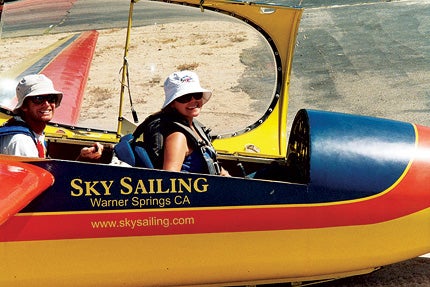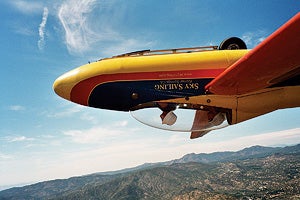 |
It was a beautiful spring day, and I was a newly minted CFI full of confidence and enthusiasm. My friend Peter and I had spent the past month eating, breathing and sleeping airplanes during flight instructor training. We wanted to do something special to commemorate the occasion, and Peter suggested that we head out to Warner Springs, Calif., to fly gliders.
Immediately, I was enthralled by the sleek and brightly colored Schweizer SGS 2-32 aerobatic glider. Peter decided to take the SGS 2-33 solo, as he had significant experience and a solo endorsement. I watched his takeoff, and soon he was high above the mountain ridge, soaring with the rising thermals for at least 20 minutes.
Now it was my turn to give it a shot. Since we were going to be banking more than 60 degrees and pitching more than 30 degrees, we were required to wear parachutes. My instructor, Garrett, rigged me up and reviewed the procedures for parachute deployment in the highly unlikely chance that we’d need it. I gave the pilot the thumbs-up sign, and we began to bounce along the runway. It was only a few seconds before those huge wings started developing lift and we were off the ground!
The objective for the glider pilot when behind the tow plane is to stay a little above or below the flight path of the airplane. This task was proving to be harder than it looked. I started out a little too low; then I climbed and was too high. Trying to descend a bit caused us to speed up and gain on the airplane, which put some slack in the tow rope. Garrett assisted me on the controls, and put the glider into a slip to help take out some slack at a controlled rate.
It was taking longer than I thought it would to get the hang of maneuvering the glider, and I was mentally beating myself up for not doing a better job. Then, I heard something that sounded like a rope snapping. Indeed, it was the rope snapping. Our tow rope had broken at about 700 feet AGL.
 |
“Oops, that almost never happens,” said Garrett. “Follow that road back toward the airport.” As I looked down at the rugged terrain, I thought about the fact that we were in a light wooden structure covered in painted canvas. My knees were practically knocking together when Garrett sensed my uneasiness and pointed out that our vertical speed showed a 200 fpm climb.
“Look, we picked up a little thermal,” he reassured me. By the time we were near the airport, we had gained enough altitude to make a normal approach and landing. In fact, we had gained enough altitude that we had to deploy the spoilers to help us descend.
Although I was a little shaken by what had happened, I couldn’t let this be my memory of piloting a glider. After inspecting the front of the glider (the rope had actually become untied), we reconnected a new tow rope and were back in the air. This time, I had a feel for the controls and wasn’t as awkward as the first time.
We climbed several thousand feet above the terrain, and I performed stalls into spins both left and right. It was a new experience for me to spin to the right, as most powered aircraft have a harder time doing so because of torque effect. Something unique about spin recovery is the aggressive simultaneous rudder/elevator input necessary to stop the rotation.
I performed a few aileron rolls and looped when Garrett said, “Do you wanna see what this thing can really do?” Before I got “yes!” out of my mouth, into my field of vision came sky, ground, sky, ground, sky. Were we upside down or right side up? I really couldn’t tell at that point. The glider was capable of much more spirited aerobatics than I had imagined!


